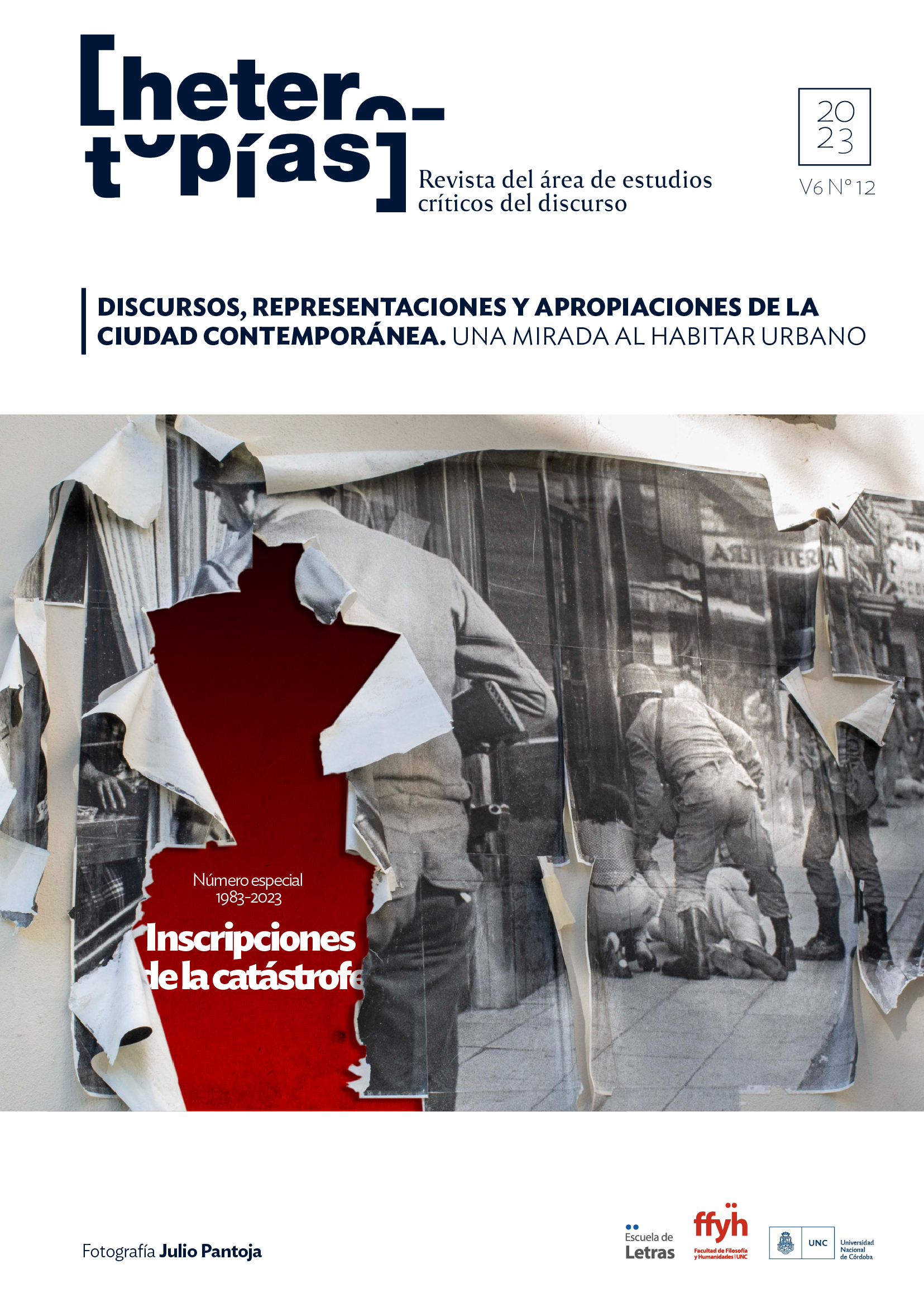A section with smell. Municipal solid waste: territorial transformation and social segregation
Main Article Content
Abstract
This article is part of the field of urban planning, with a theme linked to territorial
transformation and social segregation. It is intended to make a general reflection on the
specific problems of management and perceptions generated from urban solid waste
(MSW) in Latin American cities, putting the lens on the places of final disposal of the
same. In addition, reflections are formulated for a possible approach to the problem from
scientific activity. This is a first and brief overview of this topic analyzed from the
spatial/social perspective.
Downloads
Article Details

This work is licensed under a Creative Commons Attribution-NonCommercial-ShareAlike 4.0 International License.
Those authors who have publications with this journal, accept the following terms: Those authors who have publications with this journal, accept the following terms:
a. The authors will keep their copyright and guarantee to the journal the right of first publication of their work, which will be simultaneously subject to the Creative Commons Attribution - Non-Commercial - Share Alike (by-nc-sa) Attribution License; no commercial use of the original work or any derivative works is allowed, the distribution of which must be done with a license equal to the one that regulates the original work.
b. Authors may adopt other non-exclusive license agreements for the distribution of the published version of the work (e.g., deposit it in an institutional telematic archive or publish it in a monographic volume) provided that the initial publication in this journal is indicated.
c. Authors are allowed and recommended to disseminate their work through the Internet (e.g. in institutional telematic archives or on their website) before and during the submission process, which may lead to interesting exchanges and increase the number of citations of the published work. (See The effect of open access).
How to Cite
References
Ambrosini, C. (2004). “El juego: paidía y ludus en Nietzsche”. La metafísica del juego. Buenos Aires: Eudeba.
Arenas, M. (2 de Marzo de 2018). América Latina: Un continente forrado en basura. Cuando la expansión del consumo no va parejo con la infrastructura que procese los desechos. Obtenido de Aleteida: https://es.aleteia.org/2018/03/02/america-latina-un-continenteforrado-en-basura/
Bauman, Z. (2005). Vidas desperdiciadas, La modernidad y sus Parias. Buenos Aires: Ediciones Paidós Ibérica.
BBC News Mundo. (7 de febrero de 2022). "Imperialismo de la basura": por qué América Latina se ha convertido en "el nuevo basurero" de Estados Unidos. Obtenido de https://www.bbc.com/mundo/noticias-america-latina-59874573
BID. (2019). Reciclaje urbano: residuos citadinos y su gestión integral en Costa Rica. Banco Interamericano de Desarrollo, Desarrollo Urbano. Obtenido de https://blogs.iadb.org/ciudades-sostenibles/es/residuos-citadinos-y-su-gestion-integral-encosta-rica/
Brailovsky, A. (2009). Historia Ecológica de Iberoamérica, TOMO ll: De la Independencia
a la Globalización. Buenos Aires: Ci Capital Intelectual.
Castells, X. E. (2009). Reciclaje de residuos industriales. Residuos Solidos Urbanos y Fangos de Depuradora (II ed.). (X. Elias, Ed.) Madrid: Diaz de Santos. FICYT. (1998).
FICYT (Fundación para el Fomento en Asturias de la Inves Contaminación e Ingeniería Ambiental. Degradación del suelo y tratamiento de residuos. Fundación para el Fomento en Asturias de la Investigación Científica Aplicada y la Tecnológica, 436. Obtenido de
https://books.google.com.ar/books/about/Contaminaci%C3%B3n_e_ingenier%C3%ADa_am biental.html?id=_fhuswEACAAJ&redir_esc=y
García, H., Toyo, L., Acosta, Y., Rodríguez, L., & Zauahre, M. E. (2014). Percepción del manejo de residuos sólidos urbanos (fracción inorgánica) en una comunidad universitaria. Multiciencias, 14(3). Obtenido de chrome-
extension://efaidnbmnnnibpcajpcglclefindmkaj/https://www.redalyc.org/pdf/904/90432809002.pdf
García, L. (2008). Aproximación epistemológica al concepto de ciencia: una propuesta básica a partir de Kuhn, Popper, Lakatos y Feyerabend. México: Andamios, versión impresa ISSN 18700063.
Giddens, A. (1982). Hermenéutica y Teoría Social” del libro, “Profiles and Critiques in Social Theory. Los Ángeles, UCP.
Gudiño, M. E. (2015). Transformaciones territoriales asociadas a la globalización. Una reflexión teórica-metodológica. Tiempo y Espacio. Obtenido de http://revistas.ubiobio.cl/index.php/TYE/article/view/1689
Habitat III ONU. (2016). La nueva agenda urbana. Habitat III. Quito. Obtenido de https://onuhabitat.org.mx/index.php/la-nueva-agenda-urbana-en-espanol
Harvey, D. (2013). Ciudades Rebeldes: Del derecho de la ciudad a la revolución urbana. Madrid: Akal.
Jiménez, N. (2017). El residuo: producto urbano, asunto de intervención pública y objeto de la gestión integral. SciELO, 11(22). Obtenido de
https://www.scielo.org.mx/scielo.php?script=sci_arttext&pid=S2007-81102017000100158
Lefebvre, H. (1974). La produccion del espacio. Revista de Sociología, 219-229.
Linares, S. (2013). Las consecuencias de la segregación socioespacial: un análisis empírico sobre tres ciudades medias Bonaerenses (Olavarría, Pergamino y Tandil). SciELO, 14(14). Obtenido de http://www.scielo.org.ar/scielo.php?script=sci_arttext&pid=S1853-36552013000100001#:~:text=La%20segregaci%C3%B3n%20socioespacial%20es%20un,redu cci%C3%B3n%20de%20las%20interacciones%20con NU. (2019). Creciendo a un ritmo menor, se espera que la población mundial alcanzará 9.700 millones en 2050 y un máximo de casi 11.000 millones alrededor de 21000: Informe de la ONU. Obtenido de chrome-extension://efaidnbmnnnibpcajpcglclefindmkaj/https://population.un.org/wpp/Publications/Files/WPP2019_PressRelease_ES.pdf
Pérez Porto, J., & Gardey, A. (2014). Definición de relleno sanitario - Qué es, Significado y Concepto. Definicion.de. Obtenido de https://definicion.de/relleno-sanitario/Saavedra, V. F. (2017). Gestión de residuos y segregación urbana: Villa estaciones ferroviarias de Puente Alto, Santiago de Chile (1985-2015). Urbano, 20(36), 42-53. Obtenido de http://revistas.ubiobio.cl/index.php/RU/article/view/2738
Solíz, M. F. (2011). La cartografía de la basura en el Ecuador. Ventilando los trapos sucios.... Universidad Andina Simón Bolívar. Quito: Alerta Naranja Edición Especial. Obtenido de https://repositorio.uasb.edu.ec/bitstream/10644/4976/1/Soliz%2C%20F-CON-038La%20cartografia%20de%20la%20basura.pdf
Tardín, R. (2007). Los Paisajes de la ciudad oculta. In: Nogué, Joan (ed.). La construcción social del paisaje. Obtenido de https://www.researchgate.net/publication/280654724_Los_paisajes_de_la_ciudad_oculta
